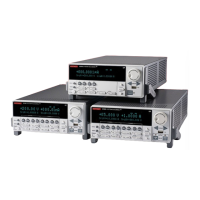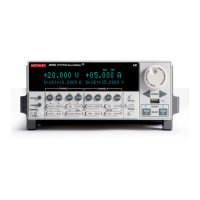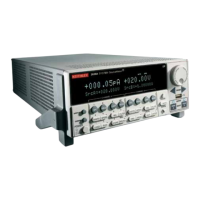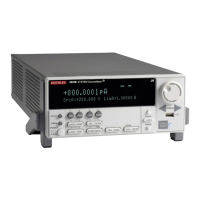0B System SourceMeter® Instrument Reference Manual Section 3:
2600BS-901-01 Rev. C / August 2016 3-55
Using the release function of the hardware lines
Use the release function to allow the hardware line to output another external trigger when the pulse
width is set to 0.
Setting the pulse width to 0 results in an indefinite length pulse when the assert function is used to
output an external trigger. When an indefinite length pulse is used, the release function must be used
to release the line before another external trigger can be output.
The release function can also be used to release latched input triggers when the hardware line mode
is set to Synchronous. In Synchronous mode, the receipt of a falling edge trigger latches the line low.
The release function releases this line high in preparation for another input trigger.
The programming example below illustrates how to output an indefinite external trigger.
-- Set digio line 1 to output an indefinite external trigger.
digio.trigger[1].mode = digio.TRIG_FALLING
digio.trigger[1].pulsewidth = 0
digio.trigger[1].assert()
-- Release digio line 1.
digio.trigger[1].release()
-- Output another external trigger.
digio.trigger[1].assert()
For information about hardware lines, see Digital I/O port and TSP-Link synchronization lines (on
page 3-41).
Using the set function to bypass SMU event detectors
The set function is useful whenever you want the source-measure unit (SMU) to continue operation
without waiting for a programmed trigger event.
There is a set function for each SMU event detector. When called, the function immediately satisfies
the event detector, allowing the SMU to continue through the trigger model.
An example of when the set function can be used is when you want the SMU to immediately perform
an action the first time through the trigger model, even if a programmed trigger event does not occur.
The set function can be used to start actions on the SMU if there is a missed trigger event.
The programming example below illustrates how to have the SMU immediately perform an action the
first time through the trigger model, even if a programmed trigger event does not occur.
-- Immediately sets the arm event detector of SMU A
-- to the detected state.
smua.trigger.arm.set()
-- Sets the Measure Event Detector of SMU A.
smua.trigger.measure.set()
Event detector overruns
If a second trigger event is generated before an event detector clears, the trigger object will generate
a detector overrun. Detector overruns can be checked by reading the overrun attribute of the trigger
object. The attribute is set to true when an overrun occurs. The clear() function can be used to
immediately clear the event detector, discarding any history of previous trigger events. The clear()
function also clears any detector overruns.
